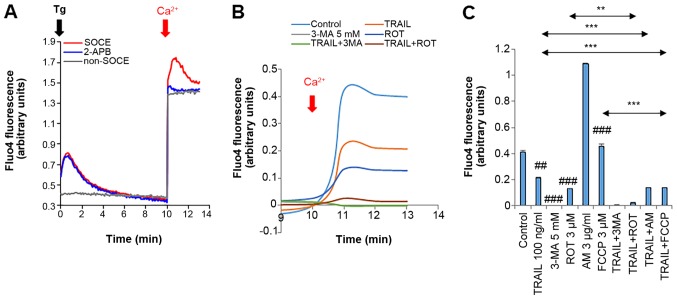Figure 7.
Reduced SOCE is associated with TRAIL sensitization. (A) A375 and (B and C) A2058 cells were suspended in a Ca2+-free buffer (HBSS supplemented with 1 mM EGTA) and were loaded with Fluo4-AM. The probe-loaded cells were immediately treated with 2 µM thapsigargin (Tg, black arrow) and incubated for 10 min to deplete the intracellular Ca2+ stores. Subsequently, 2 mM Ca2+ was added to the cells (dark red arrow). Following the addition of Tg, the fluorescence was monitored at 1, 3, 5, 10, 11, 12 and 13 min with excitation and emission at 485 and 538 nm, respectively. To validate the SOCE, the probe-loaded cells in the Ca2+-free buffer were treated as described above in the presence of 2-APB (10 µM). For non-SOCE measurement, the probe-loaded cells in the Ca2+-free buffer were treated with medium, and then added with 2 mM Ca2+. In (B and C), the probe-loaded cells in the Ca2+-free buffer were treated with the agents at the indicated concentrations alone or in combination. In (C), the data represent the means ± SD of the average fluorescence intensity during 10-13 min. Data were analyzed by ANOVA followed by Tukey's post hoc test. ##P<0.01, ###P<0.001 vs. control; **P<0.01 and ***P<0.001 (n=3). TRAIL, tumor necrosis factor-related apoptosis-inducing ligand; 3-MA, 3-methyladenine; ROT, rotenone; AM, antimycin A; FCCP, carbonyl cyanide-p-trifluoromethoxyphenylhydrazone.

